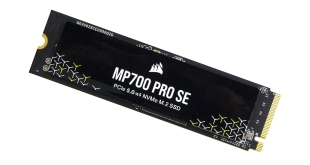We are examining the AMD Ryzen 9 5980HS Mobile APU inside the ASUS ROG Flow X13 laptop for use as a compute workstation and mobile gaming system. This system partners the AMD chip with 32GB of LPDDR4X-4266 memory and an Nvidia GTX 1650 Max-Q graphics card in 35W typical operation. As the graphics hardware is clearly underpowered by comparison to the CPU, we also test with ASUS' ROG XG Mobile RTX 3080 Laptop eGPU enclosure.
You may have seen our previous article highlighting some of the questionable operating behaviour of the ASUS system using default power profiles. AMD has since highlighted that the unexpected throttling behaviour is related to an ASUS Laptop MCU firmware update pushed out by Windows Update. We tried to remove this firmware update using AMD's directed process, but it was not possible.
As such, we tested the laptop in ‘Manual' Armoury Crate mode which allowed the CPU to operate at its 35W steady-state power draw figure without the unusual throttling behaviour. We also discovered that flipped the laptop into a different orientation can eliminate the throttling behaviour when the laptop understands that it has been flipped. This implies that the throttling limitations are intended or consequential in the firmware update.
Comparison comes from a variety of systems from MSI, Razer, and Lenovo. We are particularly interested in the comparison with the Intel Core i7-1165G7 ‘Tiger Lake' powered Razer Blade Stealth 13 which is realistically a direct competitor for the Ryzen 9 5980HS powered ASUS Flow X13. Comparing the Ryzen 9 chip against a Core i9-10980HK will also be interesting to see how AMD's Zen 3 part goes up against Intel's current mobile flagship.
The Razer Blade Stealth 13 was tested in its ‘Gaming' mode that allowed the Core i7-1165G7 to use aggressive short duration bursts whilst operating at 28W power for long duration all-core loads. The Lenovo Yoga Slim 7’s Ryzen 7 4800U was set to the higher performance mode that allowed a long duration power of around 25-35W and typically held at 30W according to our logs.
The MSI’s Core i9-10980HK was tested using the ‘Balanced’ power mode that was 45W long duration CPU with a short duration boost power of a little under 50W. We also tested the MSI in ‘Extreme’ mode which allowed the CPU to boost in the order of 100W initially before stabilising down to around 56W long duration.
We tested the ASUS Ryzen 9 5980HS laptop using the ‘Manual’ power mode set to 35W TDP. This allowed us to maintain aggressive short duration boost power delivery of around 60-65W and a 35W long duration operating power output.
ASUS ROG Flow X13 Laptop Test Configuration:
- Processor: AMD Ryzen 9 5980HS (8C/16T, 3.0GHz Base, up to 4.8GHz Boost, 35W Rated TDP)
- Memory: 32GB LPDDR4X 4266MHz
- Graphics Card: 4GB Nvidia GTX 1650 Max-Q (35W Tested Operation)
- Display: 13.4” 16:10 UHD 3840×2400 60Hz IPS Touch Display
- System Drive: 1TB WD SN530 NVMe SSD
- Battery: 62 Whr battery with 100W USB-C Power Adapter
- Design: 1.3kg weight with 15.8mm chassis thickness
- Operating System: Windows 10
Comparison Systems:
- Razer Blade Stealth 13 OLED (Core i7-1165G7 ‘Tiger Lake' System)
- Intel Core i7-1165G7 (4C8T, 28W Rated TDP)
- 16GB LPDDR4 4266MHz
- Nvidia GTX 1650 Ti Max-Q
- 13.3″ OLED Full HD Touch 60Hz
- 512GB Samsung NVMe SSD
- 53.1 Whr battery with 100W USB-C Power Adapter
- 1.41kg weight with 15.3mm thickness
- MSI GS66 Stealth 10SGS (Core i9-10980HK ‘Comet Lake-H' System):
- Intel Core i9-10980HK (8C/16T, 45W Rated TDP)
- 16GB DDR4 2666MHz
- Nvidia RTX 2080 Super Max-Q (80W Tested Operation)
- 15.6″ IPS-Level Full HD 300Hz
- 1TB Samsung NVMe SSD
- 99.9 Whr battery with 230W Power Brick
- 2.1kg weight with 18.3-19.8mm thickness
- Lenovo Yoga Slim 7 14ARE05 (Ryzen 7 4800U ‘Renoir' System):
- AMD Ryzen 7 4800U (8C16T, 25W Rated TDP)
- 16GB LPDDR4 4266MHz
- AMD Radeon Vega 8 iGPU
- 14″ IPS Full HD 60Hz
- 512GB SK Hynix PC401 NVMe SSD
- 60.7 Whr battery with 65W USB-C Power Adapter
- Around 1.4kg weight with thickness just under 15mm
- Razer Blade 15 Advanced (Core i7-10875H ‘Comet Lake-H' CPU):
- Specifications HERE
Tests
- Cinebench R20 – All-core & single-core CPU benchmark (CPU Compute), Stress test (Temperatures & Power Consumption)
- Cinebench R23 – All-core & single-core CPU benchmark (CPU Compute), Stress test (Temperatures & Power Consumption)
- Blender 2.91.2 – All-core rendering of the Classroom and BMW scenes (CPU/GPU Compute), Stress test (Temperatures & Power Consumption)
- HandBrake H264 – Convert 1440p60 H264 video to 1080p60 H264 using the YouTube HQ 1080p60 preset (CPU)
- HandBrake H265 – Convert 4K30 100Mbps H264 video to 1080p30 40Mbps H265 using the H.265 MKV 1080p30 preset (CPU & Memory)
- 7-Zip – Built-in 7-Zip benchmark test (CPU & Memory)
- SiSoft Sandra – Memory bandwidth and Cache & Memory Latency Test (Memory)
- AIDA64 – Memory bandwidth & memory latency (Memory)
- PCMark 10 – Modern Office & Battery Life Test (System Performance & Battery Life)
- 3DMark – Time Spy (1440p) test, Night Raid (1080p) test (Gaming)
- F1 2020 – 1920×1080 & UHD 3840×2160 (or 3840×2400) Ultra High quality preset, DX12 (Gaming)
- Grand Theft Auto V – 1920×1080 & UHD 3840×2160 (or 3840×2400) Maximum quality settings, no AA, DX11
- Shadow of the Tomb Raider – 1920×1080 & UHD 3840×2160 (or 3840×2400) Highest quality preset, no AA, DX12 version (Gaming)
- The Division 2 – 1920×1080 & UHD 3840×2160 (or 3840×2400) Ultra quality preset, no AA, DX12 version (Gaming)
 KitGuru KitGuru.net – Tech News | Hardware News | Hardware Reviews | IOS | Mobile | Gaming | Graphics Cards
KitGuru KitGuru.net – Tech News | Hardware News | Hardware Reviews | IOS | Mobile | Gaming | Graphics Cards




